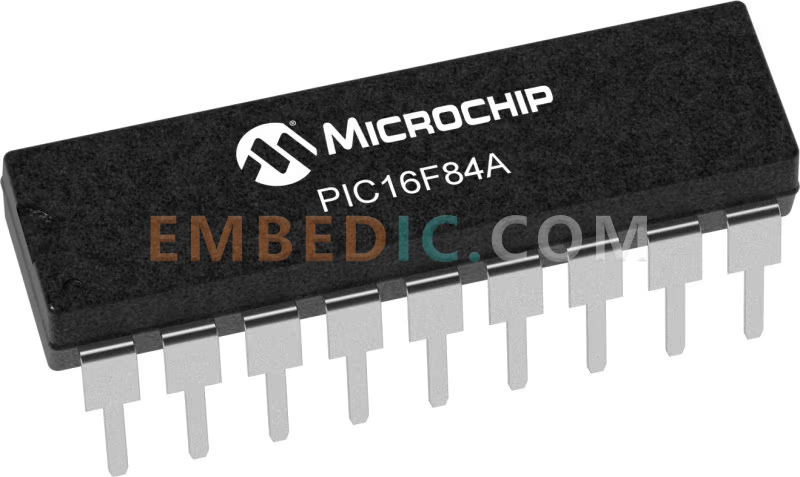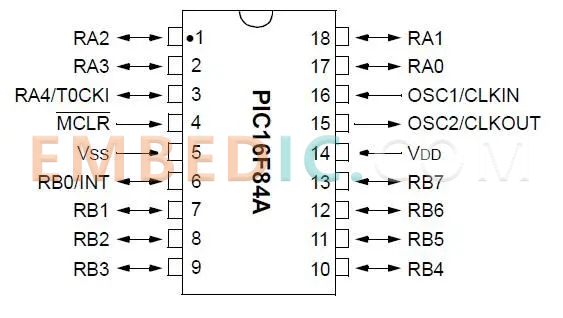The PIC16F84A is a popular 8-bit microcontroller manufactured by Microchip Technology, which is now part of Microchip Technology Inc. It's part of the PIC (Peripheral Interface Controller) family, known for its ease of use, low cost, and versatility. The PIC16F84A is often used in a variety of embedded systems and projects, thanks to its simplicity and reliability.

A PIC microcontroller is a type of microcontroller chip that is part of the PIC (Programmable Integrated Circuit) family developed by Microchip Technology Inc. PIC microcontrollers are widely used in various embedded systems and electronic devices because of their affordability, versatility, and ease of use.
Features of PIC microcontrollers include:
Here are the pinout information of PIC16F84A,

|
Pin Name |
PDIP No. |
SOIC No. |
SSOP No. |
I/O/P Type |
Buffer Type |
Description |
|
OSC1/CLKIN |
16 |
16 |
18 |
I |
ST/CMOS(3) |
Oscillator crystal input/external clock source input. |
|
OSC2/CLKOUT |
15 |
15 |
19 |
O |
— |
Oscillator crystal output. Connects to crystal or resonator in Crystal Oscillator mode. In RC mode, OSC2 pin outputs CLKOUT, which has 1/4 the frequency of OSC1 and denotes the instruction cycle rate. |
|
MCLR |
4 |
4 |
4 |
I/P |
ST |
Master Clear (Reset) input/programming voltage input. This pin is an active low RESET to the device. |
|
PORTA |
— |
— |
— |
— |
— |
Bi-directional I/O port. |
|
RA0 |
17 |
17 |
19 |
I/O |
TTL |
— |
|
RA1 |
18 |
18 |
20 |
I/O |
TTL |
— |
|
RA2 |
1 |
1 |
1 |
I/O |
TTL |
— |
|
RA3 |
2 |
2 |
2 |
I/O |
TTL |
— |
|
RA4/T0CKI |
3 |
3 |
3 |
I/O |
ST |
Can also be selected to be the clock input to the TMR0 timer/counter. Output is open drain type. |
|
PORTB |
— |
— |
— |
— |
— |
Bi-directional I/O port. PORTB can be software programmed for internal weak pull-up on all inputs. |
|
RB0/INT |
6 |
6 |
7 |
I/O |
TTL/ST(1) |
RB0/INT can also be selected as an external interrupt pin. |
|
RB1 |
7 |
7 |
8 |
I/O |
TTL |
— |
|
RB2 |
8 |
8 |
9 |
I/O |
TTL |
— |
|
RB3 |
9 |
9 |
10 |
I/O |
TTL |
— |
|
RB4 |
10 |
10 |
11 |
I/O |
TTL |
Interrupt-on-change pin. |
|
RB5 |
11 |
11 |
12 |
I/O |
TTL |
Interrupt-on-change pin. |
|
RB6 |
12 |
12 |
13 |
I/O |
TTL/ST(2) |
Interrupt-on-change pin. Serial programming clock. |
|
RB7 |
13 |
13 |
14 |
I/O |
TTL/ST(2) |
Interrupt-on-change pin. Serial programming data. |
|
VSS |
5 |
5 |
5,6 |
P |
— |
Ground reference for logic and I/O pins. |
|
VDD |
14 |
14 |
15,16 |
P |
— |
Positive supply for logic and I/O pins. |
Specifications:
Memory:
Peripherals:
Features:
Simple Instruction Set: The PIC16F84A features a straightforward and easy-to-understand instruction set, making it suitable for beginners and educational purposes.
Reprogrammable Flash Memory: The flash program memory can be reprogrammed, allowing for easy updates and modifications to the code.
I/O Ports: It has two 8-bit bi-directional I/O ports (PORTA and PORTB) that can be configured for various input and output functions.
Clocking Options:
Low-Voltage Programming: It supports low-voltage programming, making it easier to program and reprogram the device.
Interrupt-on-Change: Several I/O pins support interrupt-on-change, allowing the microcontroller to respond to external events quickly.
Multiple Packaging Options: Available in various package types, including PDIP, SOIC, and SSOP, to suit different applications.
Operating Voltage Range: Typically operates from a voltage supply range of 2.0V to 6.0V.
I/O Weak Pull-ups: PORTB pins can be software programmed to have internal weak pull-ups on all inputs.
Development Tools: Microchip provides a development ecosystem, including MPLAB X IDE and various programming tools, to facilitate software development for the PIC16F84A.
Applications: Commonly used in simple embedded systems, hobbyist projects, robotics, home automation, and industrial control applications.
Cost-Effective: The PIC16F84A is known for its cost-effectiveness, making it a good choice for projects with budget constraints.
Timer Function:
The PIC16F84A microcontroller is equipped with an 8-bit timer that can function as both a timer and a counter. It provides the flexibility to select between timer and counter modes. When the T0CS (OPTION_REG<5>) bit is cleared, the timer mode is chosen. In contrast, setting this bit selects the counter mode. In timer mode, it increments with the instruction cycle, while in counter mode, it counts both the rising and falling edges of an external signal.
In-Circuit Serial Programming:
The PIC16F84A is widely employed for in-circuit programming due to its USART (Universal Synchronous Asynchronous Receiver Transmitter) module. This module comprises a transmission pin (Tx) for sending serial data to other devices and a receive pin (Rx) for receiving serial data. This capability facilitates communication and programming while the microcontroller is connected within a circuit.
Watchdog Timer:
The PIC16F84A features a built-in watchdog timer that can be programmed to serve a critical role. This timer acts as a safeguard against program hangs or infinite loops by triggering a reset of the microcontroller. Essentially, the watchdog timer functions as a countdown timer, initially set at 1000, and counts down to zero. It must be periodically reset, typically every 3 instructions, to prevent it from reaching zero under normal operation. This reset prevents the microcontroller from getting stuck in unresponsive states.
Sleep Mode:
The microcontroller includes a power-saving sleep mode that enables the system to enter a low-current power-down state. Exiting the sleep mode can be triggered by various events, such as interrupts, the watchdog timer, or an external reset. The sleep mode conserves power when the device is not actively processing.
Power-On Reset:
The PIC16F84A incorporates a power-on reset feature, which automatically resets the microcontroller when it is powered on. This serves as a safeguard against any glitches or unexpected behavior that might have occurred prior to the power-up sequence. It ensures that the microcontroller starts in a known and stable state, eliminating any prior malfunctions.
Embedded Control Systems: The PIC16F84A is often used as the central processing unit in various embedded control systems, including:
Hobbyist Projects: It's a popular choice among hobbyists and electronics enthusiasts for DIY projects, such as:
Educational Projects: Due to its straightforward architecture and instruction set, the PIC16F84A is used in educational environments to teach the fundamentals of microcontroller programming and digital electronics.
Security Systems: Basic security systems like access control or simple alarm systems can be implemented using this microcontroller.
Timers and Counters: It can serve as a timer or counter in applications that require precise timing or event counting. For example:
Communication Devices: While it lacks advanced communication capabilities, it can still be used for basic serial communication interfaces, such as UART, SPI, or I2C, to interface with other devices.
Download PIC16F84A microcontroller datasheet here>>
The PIC16F84A microcontroller is manufactured by Microchip Technology Inc. Microchip Technology Inc. is a global semiconductor manufacturer headquartered in Chandler, Arizona, USA. It is one of the leading companies in the field of microcontrollers and analog semiconductors. The company was founded in 1987 and has a rich history of providing innovative solutions for the electronics industry. Microchip offers a wide range of products and solutions, including microcontrollers, microprocessors, analog and mixed-signal integrated circuits, memory, and various other components used in embedded systems and electronics design.
Manufacturer: Texas Instruments
IC DSP FIX/FLOAT POINT 841FCBGA
Product Categories: DSP
Lifecycle:
RoHS:
Manufacturer: Microchip
IC MCU 8BIT 32KB FLASH 28SOIC
Product Categories: 8bit MCU
Lifecycle:
RoHS:
Manufacturer: Texas Instruments
IC DGTL MEDIA PROCESSOR 529FCBGA
Product Categories: DSP
Lifecycle:
RoHS:
Manufacturer: Microchip
IC MCU 16BIT 16KB FLASH 20SOIC
Product Categories: 16bit MCU
Lifecycle:
RoHS:
Looking forward to your comment
Comment